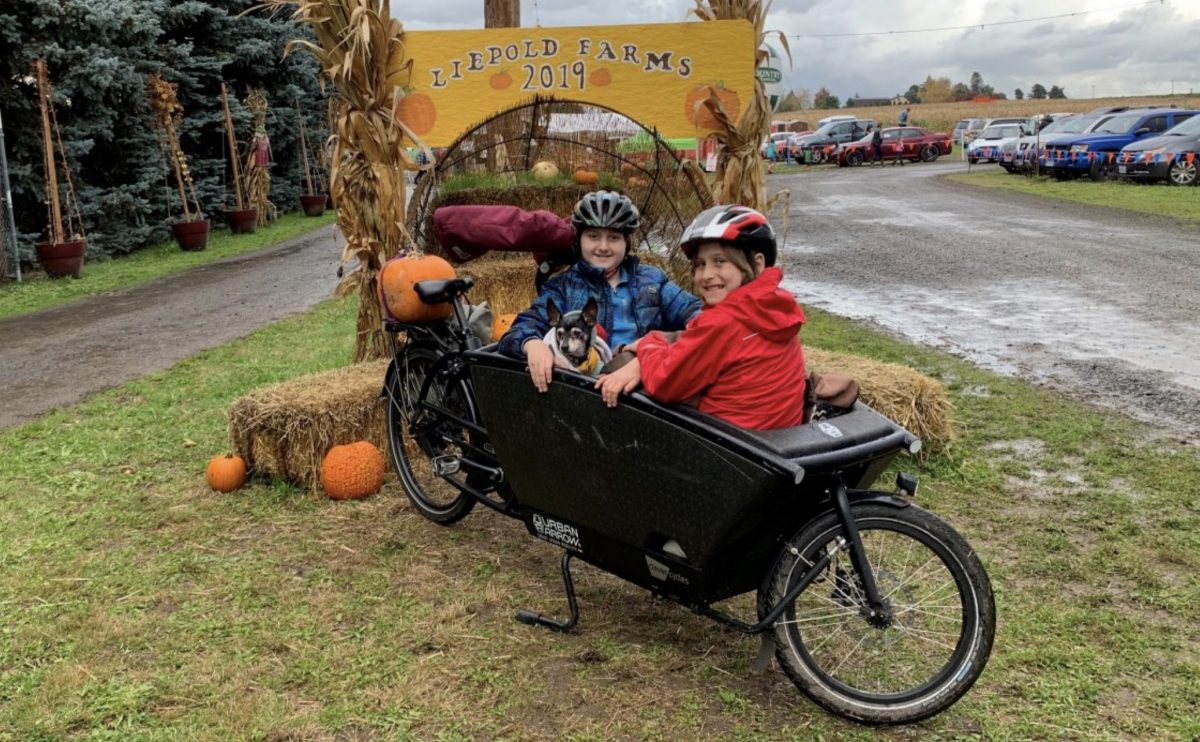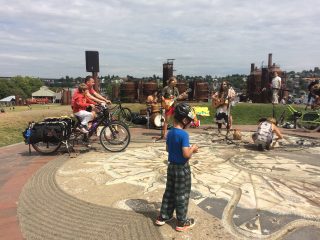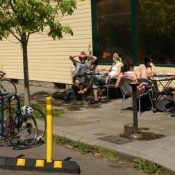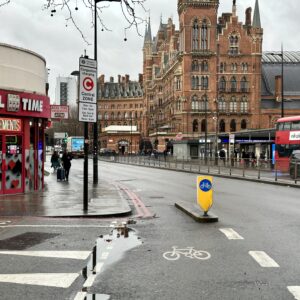
(Photos: Madi Carlson)
It’s been eye-opening and fun playing at being an electric cargo biking mom these last few weeks. Except for the “aren’t they old enough to be on their own bikes?” comments (here, not in person). And yes, they (my two boys) often ride their own bikes, but I’m borrowing an electric cargo bike so I’m putting them in the front box. We all think it’s fun.
A few great articles about e-bikes came out in the Willamette Week. It’s true! Replacing cars with e-bikes is wonderful. One of the big advantages is how the motor can increase your range. But I wonder… Are there more people like me who strive to bring their life down to a smaller – more bikeable – scale, where an e-bike isn’t as necessary?
I constantly think about this Netherlands Bureau for Tourism tweet of nearly four years ago:
Did you know that people cycle over 600 miles a year in Holland? pic.twitter.com/pn3jdY2QeS
— Visit Holland (@visitholland) January 20, 2016
I bike over 600 miles in a month. A month! None of that is recreational riding, things I need to do are just more spread out here. Former BikePortland writer Michael Andersen broke it down in detail for PeopleForBikes last year: The best-kept secret of Dutch biking: the Dutch hardly bike at all. I’d like to get my miles down, too.

Most of our biking is to and from school and to and from work. Once a year we go bike camping as a family and once a year I go bike camping sans kids. We also bike to pumpkins once a year. That’s about it for big trips. They’re all fun and exhausting and not things we could manage in the spur of the moment or more than once each year. We gravitate to venues and events in our neighborhood and often skip fun things that aren’t close by.
Three years ago we watched the cargo-bike-powered Pleasant Revolution Biketopia Music Festival and I fell in love with their concept of challenging the idea that it’s inconvenient for a touring band to travel by bicycle. That’s exactly how our big trips feel: it’s not convenient to bike 15 miles to Boring (a city south of Portland) for pumpkins, but it’s such a treat that we can bike to a farm and I like that it’s an all-day excursion that leaves us too exhausted to carve our pumpkins once we make it back home.
Convenience shouldn’t be a metric we measure transportation by if we really care about driving less.
Advertisement
My kids are 12 and 10 and life seems quite different now than when I was that age. From ages eight to 17 I lived in Albany, California — a tiny city of five square walkable and bikeable miles. I walked four blocks to elementary school and biked or walked a mile to middle school. We often hung out at the shopping center in neighboring El Cerrito, 1.5 miles from home. We occasionally walked 2.5 miles to Telegraph Avenue in Berkeley. The flat 1.5 miles to El Cerrito Plaza felt easy and close, but the 2.5 hilly miles to Berkeley (too hilly to bike, we kids decided) felt enormous…but not inconvenient.
But more than the distances at which things are spaced in a city the size of Portland, cars are different now. We read about deadly SUVs in a BikePortland Monday Roundup a year ago. Not to mention the preponderance of people texting while behind the wheel. Every day I see people staring at phones while driving. I also see people in cars ignoring stop signs when they don’t see automobile cross-traffic and lots of driving above the speed limit. These things terrify me. I’m not terrified to the point I don’t want to bike with my kids (and choosing routes carefully makes a big difference!) but I feel less anxious when we’re all together and even less anxious when I’m piloting a bike with them as passengers.
Where were you at ages 12 and 10, and could you get around easily? Do you think it’s possible to bike less in Portland, or anywhere in America? For those of you putting bigger kids on cargo bikes, keep at it! I’m sorry for the few unsupportive comments on my recent posts and I hope you don’t feel deterred. Being able to carry kids by bike never gets old. I love that the e-assist and low center of gravity of the Urban Arrow allows me to tote my kids around again.
Here’s one last bit of inspiration in the form of the principles of the Pleasant Revolution bike-based music festival:
➤ slow is beautiful
➤ local is profound
➤ sustainable living is richer
➤ we can free ourselves from the culture of fear that drives our consumerism and apathy
➤ fundamental change is necessary and possible
➤ to change the world, we must change our own consciousness and lifestyle
➤ humanity now, perhaps more than in any previous time, has an opportunity to create a new, saner, more loving world
➤ the bicycles liberate
Thanks for reading!
Remember, we’re always looking for people to profile. Get in touch at madidotcom [at] gmail [dot] com if it sounds like fun to you.
— Madi Carlson, @familyride on Instagram and Twitter
Browse past Family Biking posts here.
BikePortland needs your support.







Thanks for reading.
BikePortland has served this community with independent community journalism since 2005. We rely on subscriptions from readers like you to survive. Your financial support is vital in keeping this valuable resource alive and well.
Please subscribe today to strengthen and expand our work.
Wow Madi I agree with you so very much! I do wonder if things in the mythical Netherlands has changed as our world has changed from more stable (lifetime?) jobs where you could plan where you live around where you work. Not that this change is for the better and some of it is definitely driven by car use, not the other way around, but it’s there. I know that personally I shifted to the e-bike as my commute went from 5 miles to 11 miles each way. I really wish I wasn’t riding 500+ miles/month, however I’m grateful for the ebike that lets me do it in comfort. Prior to this year, most of what myself and my family needed/wanted was within a 5 mile radius of our house. Which is why Portland is awesome. But then things changed beyond my control, as I’m sure it has for many people out there.
So how do we get to the goal of keeping everything close and comfortable to get to outside of a car and yet acknowledge the economic/financial world we live in? I have some ideas, but it’s not as simple as “just move” and/or “just get another job”…..
The scale of our neighborhood Portland is great, with most daily trips within a mile. The struggle for us is the scale of school sports leagues, where some of the games are not within reasonable biking distance and take us over an hour on bus to get to. We rarely see anyone arrive to kids sports events by anything other than a car, which is such a shame.
I so agree about the neighborhood scale. I joke that I try never to leave SE Portland, but actually, not a joke! I also recognize the privilege that allows me to afford a home in such an amenity-rich neighborhood, and to choose to pay more for things at a close, small neighborhood store rather than heading to Costco. (Though there are other benefits to supporting neighborhood businesses and we can debate externalized costs from the big boxes, in terms of the final “true” cost of goods.)
I had one more question about tweens and biking as you wrap up this series: as your kids get older and have more opinions and preferences about their mode of travel, how have your family discussions about transportation choices changed? For example, how does the conversation go when, hypothetically, they have a soccer game out at Delta Park or a friend’s birthday party at a trampoline place in the suburbs that are beyond comfortable biking distance? Are those no-gos, or do you offer alternative transportation choices? Or what about instances where you want/need them to get on the bike but they don’t want to, like they have a cold and don’t feel like biking to the grocery store? Do your kids ever say, I wish we could just drive there like everyone else!
I’ve been thinking about this since your column last week, and how it is and isn’t the same as other family values we share with our kids, like eating vegetarian or a religious tradition. You name it, kids can find a way to reject it particularly as they get into adolescence. Heck, trying to get my three-year-old in a car seat isn’t an easy sell some days; it’s not like cars are the secret mode of transportation that makes all children happy and compliant. So in many ways, I imagine it’s an evolving discussion about family values and priorities and parenting, in the sense of, these are the options for our family even though other families may be different and here’s why. But I’m curious about the dimensions of the discussion in your house Madi, or other commenters, and any changes you’ve made to the available transportation choices in response to kids’ preferences. And the other difference that occurs to me is the logistical reality that if the kids won’t get on the bike or won’t pedal, you can’t really make them which can change plans for the whole family. (As opposed to a kid having different food preferences, which doesn’t necessarily force everyone else to skip dinner.)
According to this morning’s ABC news, about a third of all adult children in the U.S. still live with their parents. Tweens (and older) being pedaled about by mom could become pretty much normal in coming years.
Hurry Mike! I think someone is out on your lawn.
Your comments on this topic are well known, provide no meaningful substance to the conversation and seem like it makes you grumpy. Maybe just avoid these topics from now on? For ours AND your own sake?
I’m not Madi, but I’ll bite. If my kid (teenager) doesn’t feel like riding somewhere, he takes the bus. Because by this point he knows the only reason I would drive him somewhere (we do have a motor vehicle) is because it’s late at night or in a part of town that I’m not comfortable him riding or busing. But most of the places he goes are in SE and there is zero reason for him to get places either via bike or bus.
Regarding the party in the suburbs or a game (choir performance in his case) far-ish away, my first question is nearly always “are there other kids who live near us who are going that you can carpool with?”. I feel like this is a question we should ask always anyway in this situation and it’s the right thing to pile as many ppl in a car as possible, so I don’t feel like we’re mooching. And the vast majority of the time we can get him there without us driving a vehicle. It just takes some asking!
Thanks for the ideas. It seems helpful to frame the options and encourage ownership of the decisions, like researching bus routes or asking around for a ride.
Follow the middle path. Ride when you can, drive when you have to. Don’t be yourself up.
We’ve introduced a new saying to our household: “convenience kills”.
However, “the best [diet] [exercise program] [insert-name-of-good-for-you-thing-here] is the one you’ll stick to” also applies heavily, given human nature.
Being able to shrink one’s radius of necessary, frequent travel distances sounds fantastic, if one is able. Too much of modern culture and geography seems to have been hard-wired for routine, long-distance travel: proliferation of “monoculture” suburbs, affordability of housing near job centers, the “gig economy” in which there is no consistent job location, “importance inflation”/status concerns, expansion of freeways, etc. At the same time, the assumption of car travel has been marketed down our throats for the last 70 years, and also hard-wired into our geography: expansion of freeways, lack of transit options, “stroads” that are destinationless shooting galleries through the centers of cities, utter dearth of non-car infrastructure of any kind (e.g., not even bus-only lanes, let alone sidewalks or bike-only lanes), etc., etc.
So, if shrinking one’s radius is not feasible, and covering one’s radius with non-motorized or public transit options is similarly not feasible, and covering one’s radius with a single-occupancy motor vehicle has become distasteful—then it doesn’t seem like the worst compromise ever to resort to e-bike usage to cover the gap.